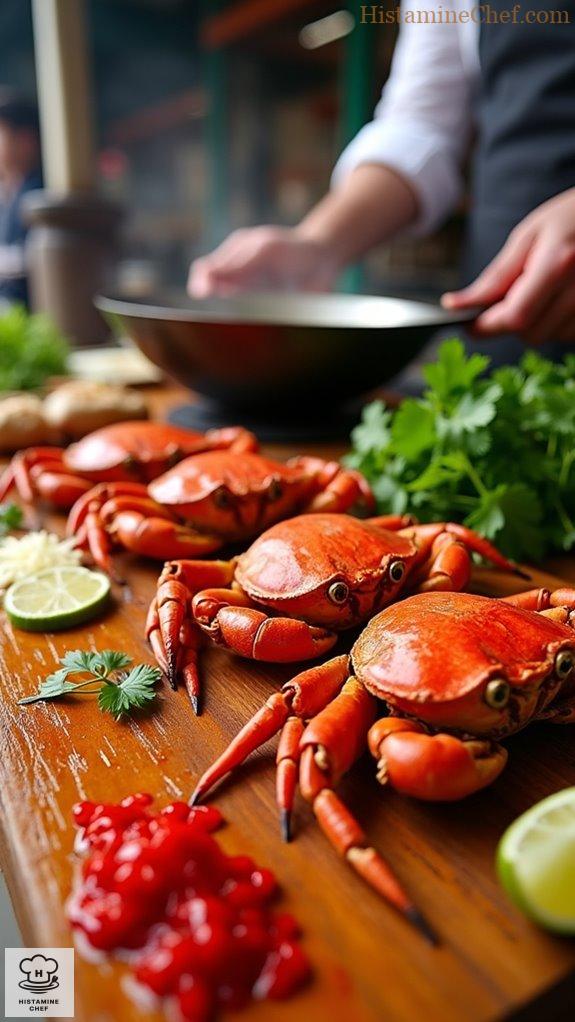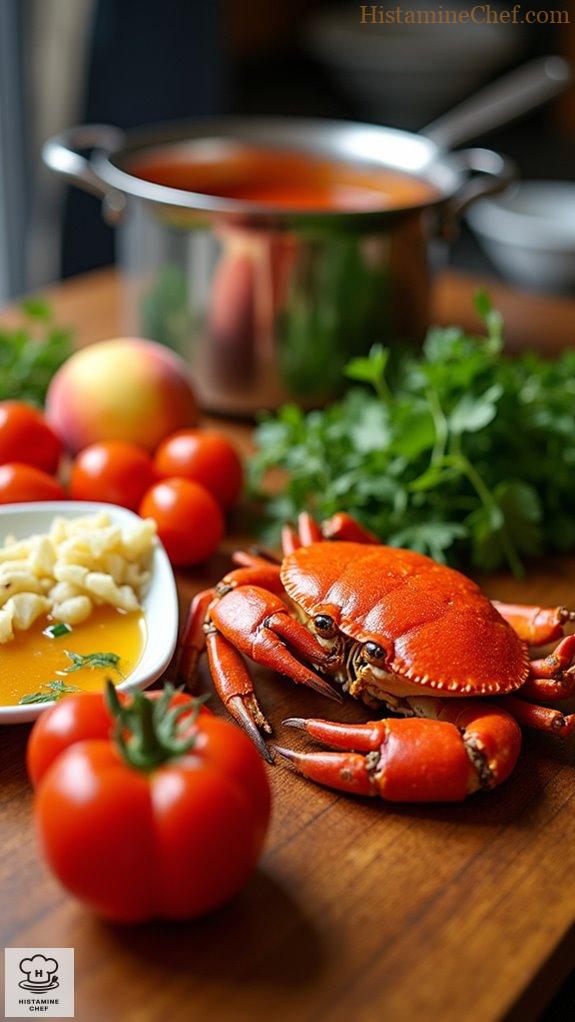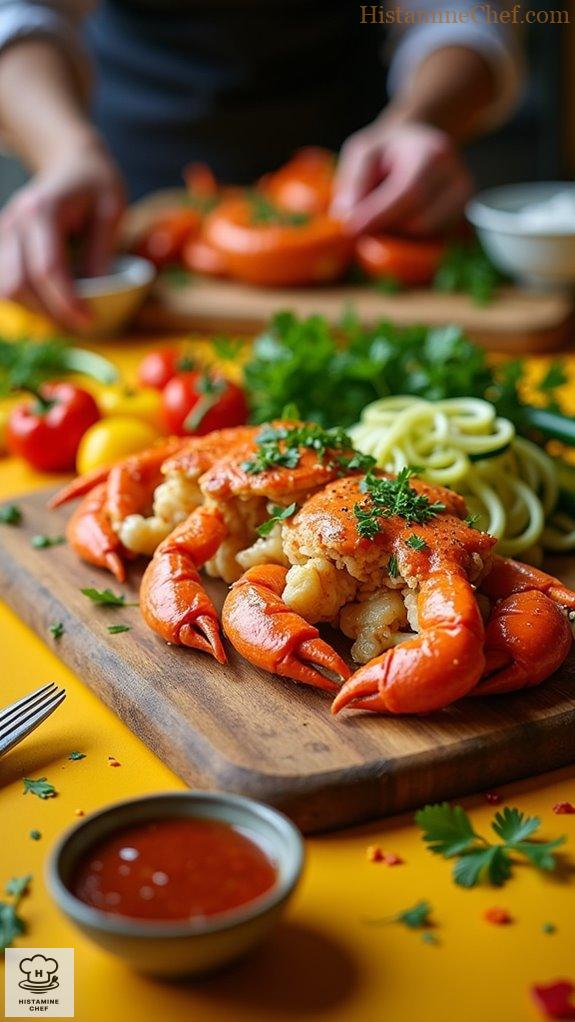Want to whip up a street-style chili crab at home while keeping your histamine levels in check? I’ve got you covered! Envision sweet crab meat enveloped in a vibrant sauce of ripe peaches and fresh herbs, skipping the onions and garlic for a gentle touch. Substituting chili peppers with colorful bell peppers keeps the bold flavors without the histamine hitch. Curious how this flavorsome twist turns out? There’s more to discover about this delightful dish!
Culinary Hotspot in Southeast Asia

Street food culture in Southeast Asia is vibrant and deeply rooted in the region’s history, reflecting a fusion of diverse culinary traditions. Countries like Singapore, Malaysia, and Thailand are known for their bustling hawker centers and night markets, where local vendors serve up an array of delectable dishes.
The street food scene has evolved over centuries, influenced by trade, migration, and cultural exchanges. Historically, it catered to the working class, offering affordable yet flavorful meals that encompassed local ingredients and spices. Vendors often specialize in particular dishes, creating unique recipes passed down through generations.
One iconic dish, chili crab, exemplifies this culinary tradition. Originating from Singapore in the 1960s, this dish combines fresh crab with a spicy tomato and chili sauce, showcasing the region’s love for bold flavors.
Today, street food festivals and markets draw both locals and tourists, celebrating not only sustenance but also the rich tapestry of Southeast Asian culinary heritage.
Crabs Simmered in Spicy Sauce

Street vendors cook the enticing Street Style Chilli Crab by first cleaning and preparing live crabs, ensuring the freshest flavor. They simmer the crabs in a robustly flavored spicy sauce made from a combination of garlic, ginger, and a blend of aromatic and fiery chili paste, which typically includes red chilies for heat and depth.
The crabs are added to the bubbling sauce, where they soak up the flavors while cooking until they’re tender and beautifully coated. Finished off with a garnish of fresh coriander and a squeeze of lime, these crabs are served hot and steaming, inviting customers to enjoy the messiness of cracking shells and dipping the sweet meat in the sauce.
Ingredients:
- 4 live crabs (about 1 kg)
- 3 tablespoons chili paste
- 4 cloves garlic, minced
- 2 tablespoons grated ginger
- 2 tablespoons oil (for frying)
- 1 tablespoon sugar
- Fresh coriander for garnish
- Lime wedges for serving
Cooking Steps:
- Clean the crabs thoroughly.
- Heat oil in a large pan.
- Sauté garlic and ginger until fragrant.
- Add chili paste and sugar, stir well.
- Add crabs to the pan, coat evenly.
- Simmer until crabs turn bright red.
- Garnish with fresh coriander.
- Serve hot with lime wedges.
Make Your Own Spicy Sauce

To make your own spicy sauce for Street Style Chilli Crab at home, start by blending allowed ingredients like fresh cherry tomatoes, ripe peach slices, and sweetener of your choice, such as honey or maple syrup, to create a sweet and tangy base.
Add minced garlic and fresh ginger for flavor, and balance with a splash of distilled white vinegar to keep it zesty without using any restricted ingredients.
If you want a kick, finely chop some fresh herbs like cilantro or basil to stir-in just before serving.
Cook the sauce over medium heat until it thickens, then coat your freshly cooked crab, and enjoy!
Changes for Homemade Recipe:
- Use fresh cherry tomatoes
- Add ripe peach slices
- Sweeten with honey or maple syrup
- Include minced garlic and fresh ginger
- Use distilled white vinegar
- Stir in fresh herbs before serving
- Cook until sauce thickens
Low Histamine Variation of Chilli Crab

Street food often embodies rich flavors and spices, but for those with histamine intolerance, it can pose significant challenges. Many popular street foods, including variations like chilli crab, utilize ingredients high in histamine or liberators, aggravating symptoms. Caution should be taken to avoid these foods to maintain a balanced and low-histamine diet. Understanding how to read food labels is crucial for identifying hidden histamines in packaged products.
Eating street food like chilli crab can be problematic for individuals with histamine intolerance because ingredients such as crab and spices can trigger reactions. According to the SIGHI list, seafood can be restricted when preserved, while many spices are categorized as high in histamine. Moreover, sauces and condiments often contain restricted ingredients, further increasing histamine levels. Therefore, adapting recipes is vital for safer enjoyment of such dishes. Adjusting cooking methods is also essential, as some techniques can affect histamine levels in foods through prolonged heating or fermentation.
Low Histamine Chilli Crab Instructions:
- Use fresh crab meat, avoiding canned or processed versions.
- Substitute chili peppers with bell peppers or sweet paprika for flavor.
- Omit onion and garlic; instead, use fresh herbs like parsley for seasoning.
- Use coconut oil instead of any oils that may be restricted.
- Replace soy sauce with a mix of distilled white vinegar and agave.
- Avoid any pre-made sauces; instead, create a homemade sauce from allowed ingredients.
- Cook crab meat fresh; avoid any dried or marinated seafood products.
- Use fresh vegetables like zucchini or carrots instead of restricted options.
- Serve with steamed rice instead of processed noodles.
- Verify all utensils and cookware are thoroughly cleaned to avoid cross-contamination.
Video Summary
Chili crab originated on the bustling streets of Singapore. In this video, we’ll explore both the authentic street version and a home-friendly low histamine variation.
Street vendors start by selecting the freshest crabs, usually mud crabs. They clean the crabs thoroughly, removing the gills and any unwanted parts, ensuring freshness. Next, they boil the crabs in water for about ten minutes until they turn vibrant red.
While the crabs cook, vendors prepare a spicy sauce from chili paste, garlic, ginger, and tomato sauce—this is where the magic happens! They stir-fry these ingredients in a large wok with a bit of oil. Afterward, they add the boiled crabs, coat them thoroughly in the sauce, and simmer for a few additional minutes. A dash of sugar is added for sweetness. Finally, they finish with a sprinkle of chopped cilantro, giving it a fresh aroma.
For the home low histamine version, substitute crabs with fresh, frozen crab if available. Omit the tomato sauce and replace it with a mix of apple vinegar and coconut milk. Instead of using chili paste, blend fresh ginger with a bit of sugar and steam the crabs instead of boiling them.
Skip the sugar and opt for honey instead. Using a large non-stick pan will help in tossing the crabs in the sauce. When the dish is ready, it glistens with a beautiful golden hue, showcasing a rich blend of flavors. The low histamine version remains delicious and satisfying.
Click the link in the description for the full recipe!


Leave a Reply